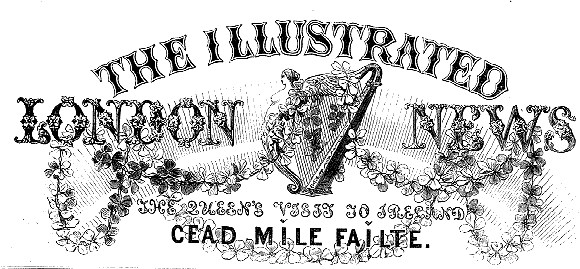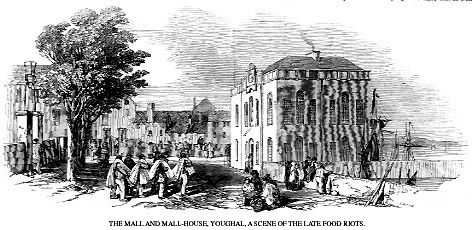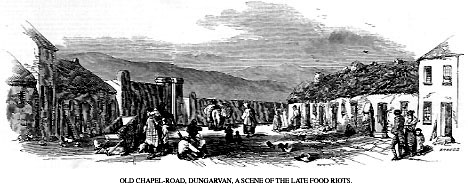
|
THE ILLUSTRATED LONDON NEWS. |
[Nov. 7, 1846. |
![]()
THE LATE FOOD RIOTS IN IRELAND.
Annexed is a pair of melancholy sketches of the localities of the late Food Riots in the south of Ireland-- Youghal and Dungarvan; the afflicting details of which have been duly reported in our Journal. The Artist has refrained from heightening the picturesqueness of these scenes; but they are stern and striking realities of the sufferings of the people, and must bespeak the sympathy of every well-regulated mind.

One of the Illustrations shows the Mall and Mall-house, or Town-hall of the seaport of Youghal, which, though merely a creek to Cork, has a considerable trade, for the accommodation of which there are extensive and commodious quays and a Custom-house. The Mall-house was erected in 1779; balls and concerts are held in it, and here, prior to the dissolution of the Corporation, were held the Borough Courts.
Youghal was the grand centre of the late Food Riots and turn-outs for wages. Our Artist was received somewhat roughly whilst he was sketching in the street, because he would not promise the mothers that their children, then working on the part of Government, should have an increase of wages over five or sixpence, which was insufficient to support them with Indian meal at 1s. 8d. per stone.
The Mall-house is a large, plain, whitewashed building: its situation and the open space which surrounds it, are well calculated to attract crowds; as well as from its large rooms affording accommodation to the Relief Committees. To the right is seen a portion of the Harbour, with the distant hills of the county of Waterford.
The other Sketch shows the Old Chapel-road, Dungarvan, on the road to Youghal, the scene of the late conflict between the military and the "food rioters;" one of the men shot was standing on the spot behind the cart in the sketch.

We add a few descriptive notes from a Correspondent:--
"Dungarvan, the scene of the late riots, is the second town in the county of Waterford, and was, from an early period, a place of some importance. Although well situated for carrying on an extensive trade, large vessels being able to come up to the quay, unfortunately, like other Irish towns equally well placed, it presents to the eye of the stranger, an appearance of want and untidiness: yet the Duke of Devonshire, to whom the manor belongs, has spent much in various improvements-- amongst others, a fine bridge has been erected by him across the river, the stone for which was actually all brought from England! This bridge consists of a single arch of 75 feet, in addition to a causeway of about 1000 feet in length, and is justly admired for its fine proportions."
The Quarter Sessions commenced at Dungarvan on Monday week. There were prosecutions entered against fifty-one persons, alleged to have been engaged in the late Food Riots in the neighbourhood. Mr. Hatchell, Q.C., was sent down especially by the Crown to prosecute the fifty-one persons alluded to. A farmer named Quinn refused to prosecute some of those poor fellows. He said "Whatever would be the consequence he never would prosecute hungry people who offered no harm or violence to person or property." Quinn had been sent to Waterford gaol for refusing to prosecute. Fleming, the poor lad that was shot in the knee by the 1st Royals in Dungarvan, on the 28th of September last, died on Tuesday night in the workhouse here, after suffering much pain from the effects of his wound. An inquest was held on the body on Sunday evening. Dr. Christian made a post mortem examination of the body, and a verdict was returned, "that the deceased had come by his death from the effects of a gun-shot wound in the knee, inflicted on him by the 1st Royal Dragoons on the 28th of September last in Dungarvan, whilst in discharge of their duty."
The prisoners stated to be engaged in the Food Riots, arrived at Dungarvan, guarded by a large force of military and police. "Never," says the Cork Southern Reporter, "have I witnessed any scene so affecting as the meeting of the prisoners and their poor hungry wives and children."
On Tuesday, the trial commenced, when fifty of the prisoners pleaded guilty; but through the wise and merciful conduct of the Crown, were discharged, on finding securities to keep the peace; but, the ringleader Patrick Power, was sentenced to twelve months imprisonment, with hard labour.
![]()